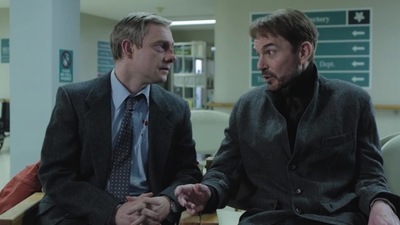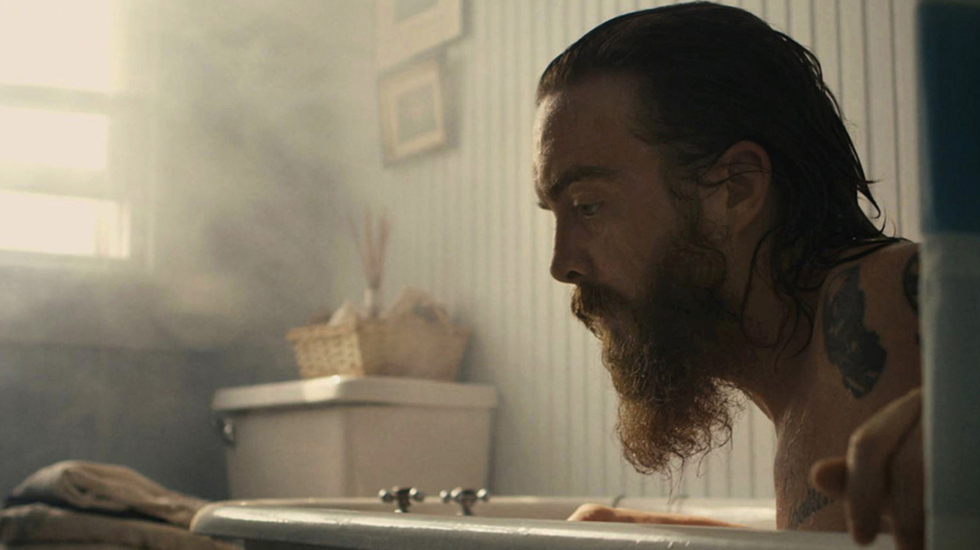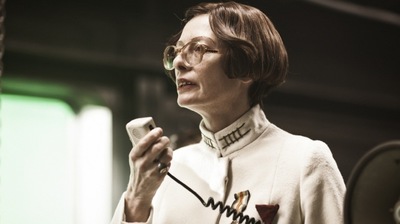
BY ZACHARY WIGON |
Under The Hood: A Close Examination of a Pivotal Scene in 'Blue Ruin'
In the inaugural edition of 'Under The Hood,' a column devoted to examining the mechanics of how narrative devices and structure are employed in cinematic storytelling, I'm giving the gears and cranks of Jeremy Saulnier's 'Blue Ruin' a close look.

Since the most common device used to create tension in narrative cinema concerns a character's desire - the protagonist of any story, typically, is the character whose desire is most closely observed - cinematic storytelling can often become lazily procedural about the way a character goes about attaining the object of desire. Sure, there are the obvious complications in any movie - character X wants thing Y, but obstacle Z keeps preventing things from working out - but all too often these complications have a predetermined, obvious feel to them. Who would've thunk it - the guy wants to get the girl, but the girl's father doesn't like him!
Jeremy Saulnier's Blue Ruin is one of the most taut, ingenious narratives I've seen on screen in some time - it's almost tailor-made for Screenwriting 101 classes.
Jeremy Saulnier's Blue Ruin is one of the most taut, ingenious narratives I've seen on screen in some time - it's almost tailor-made for Screenwriting 101 classes. Not only does the narrative's cause-and-effect chain (something to be discussed in a later column) link seamlessly from beginning to end, but Saulnier also speeds the narrative along much faster than is typical (the climax in the Hollywood version of this film comes at the end of the first act, in Saulnier's construction). Additionally, he utilizes narrative complications in a manner that is far more clever than most films.

As I mentioned above, since films are designed to follow the line of a character's desire, most films either A) do not have enough complications, and so the course by which the character attains their desire feels unrealistic, or B) have only the most stereotypical complications, which are more of a gesture toward the necessity of obstacles than a thoughtful consideration of what obstacles might realistically confront the protagonist.
This highly unusual, detailed obstacle is a powerful tool for the filmmaker to gain the audience's trust.
There are plenty of obstacles Saulnier places for his protagonist, Dwight, in Blue Ruin, but one in particular was an extremely powerful screenwriting choice. Without revealing too much detail, the film's setup explains how Dwight is seeking revenge on someone who harmed him years ago. Dwight begins plotting his revenge by researching where the man he seeks to harm will be, and going there; in another scene, we see Dwight in a store that sells firearms, considering the guns (as well as the knives) on display. But they're too expensive, and Dwight ends up just buying a postcard instead. In a following scene, Dwight winds up breaking into someone's car and stealing a revolver out of the glove compartment. After much buildup to the act of revenge, it's time to cut to the chase, right?

Wrong. The next scene features Dwight, revolver in hand, trying to remove the trigger lock from the revolver by bashing it with a rock. Now, pause for a moment and think about how many films you've seen that feature handguns. All right. Now think about how many films you've seen that feature trigger locks on those handguns. Exactly. No one in the audience would ever expect this obstacle, and so the film immediately achieves a very high level of credibility in the eyes of the audience. This highly unusual, detailed obstacle is a powerful tool for the filmmaker to gain the audience's trust. The reason is that, once the audience member realizes that Dwight is dealing with a trigger lock, they become aware of the unusual nature of this scene, and by extension, realize how it's an obstacle in advancing the narrative the filmmaker did not have to acknowledge - Saulnier could have easily moved his story forward at this juncture without any derision from the audience.
The fact that Saulnier chose to utilize the trigger lock displays to the audience how honest Saulnier is going to play the rest of the story: he's not going to give us an implausible or contrived version of events - rather, he's going to tell a story filled with realities that would never make it into most films. Once the trigger lock scene came, I was fully bought into Saulnier's world. One concession to complication - to specific detail that most films would not acknowledge - can enormously benefit the plausibility of an entire film.
Zachary Wigon is a filmmaker and film journalist/critic based in New York. He wrote and directed The Heart Machine, which premiered in competition at the 2014 SXSW Film Festival

